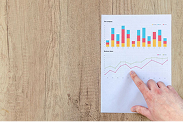E-commerce Reporting: 10 Tools & Reports You Should Start Using Now
Discover everything you need to know about e-commerce reporting.

In the same way that we glance at product displays at the mall, product pages are how eCommerce businesses take window shopping online. In short, a well-optimised product page can catch the attention of your target audience and drive higher conversion rates.
Let's go through how you can optimise the shopping process of your product pages to close deals online.
The key to crafting compelling product pages lies in understanding your target audience. When you have a firm grasp of your ideal customer's preferences, needs, and pain points, you can tailor your product page content to resonate with them. This translates into strategically highlighting features and benefits that truly matter to your audience, ultimately influencing their decision to buy.
Here are some ways to leverage customer data to tailor your product page content:
With a firm grasp of your target audience's pain points, you can now start to craft an attention-grabbing product page that resonates deeply with them. In eCommerce, this translates to crafting compelling product pages that speak directly to your customers' needs.
Your product pages should essentially say, "I do all these things, and even better, I can solve your specific pain points!"
The key to writing product descriptions that convert lies in focusing on the benefits your product offers, rather than simply listing its features. Customers are primarily interested in how a product can improve their lives or solve their problems.
For example, instead of just stating "3-speed adjustable fan," highlight the benefit: "Enjoy a customised cooling experience with three adjustable fan speeds."
Don't forget to strategically incorporate relevant SEO keywords to improve your product page’s ranking in search engine results. By understanding the search terms your target audience uses, you can optimise your descriptions to improve your ranking in search engine results pages (SERPs).
High-quality images and videos are crucial for capturing customer attention and increasing engagement on your product pages. To showcase your products effectively using multimedia, follow these guides:
Without physical interaction with products, building customer trust can be challenging. How can we bridge this gap and convince customers that our products are worth purchasing?
The answer lies in social proof – the power of user-generated content such as reviews, ratings, and testimonials. When potential customers see that others have had positive experiences shopping with you, it builds trust and credibility. Social proof acts as a form of social influence, subconsciously reassuring customers that your products are a safe bet.
A user-friendly and visually appealing product page layout is crucial for a positive customer experience. When key information is presented clearly and navigation is intuitive, customers are more likely to engage with your product and ultimately convert.
Here are some tips on using visual elements to enhance readability and focus on your product pages:
In today's digital landscape, adopting a mobile-responsive design is no longer an option—it's a necessity. With more and more people taking their shopping on the go, you’ll risk cart abandonment from potential customers if they’re met with a frustrating mobile user experience. Ensure that your site layout can be adaptable to varying resolutions, and designed to respond to the screen size constraints that come with a 5” phone screen.
Cart abandonment can also happen to eCommerce businesses simply because the checkout and online payment process is complicated. Some strategies to consider when streamlining your business’ checkout process may include:
The key to creating truly impactful product pages lies in data-driven decision-making. A/B testing allows you to compare different versions of your product pages and see which ones perform better in terms of conversions. This data-driven approach helps you identify what works best and optimise your pages for maximum impact.
Of course, when A/B testing, you should try to go for focus changes, such as:
Once you've implemented your A/B tests and optimised your product pages, it's crucial to monitor their performance and track key metrics. Tools like Google Analytics can provide valuable insights and marketing metrics into user behaviour on your product pages.
Essential success metrics that you can measure to see if your optimisation holds up include:

Optimising your product pages isn't a one-time fix—it's an ongoing process. By following the strategies outlined in this blog, you can create compelling product pages that resonate with your target audience and drive higher conversion rates.
Remember, the key is to constantly test, analyse, and adapt your approach based on data and customer feedback. This iterative process of eCommerce optimisation will ensure your product pages are continually optimised for success, ultimately leading to a thriving e-commerce business.
Need help optimising your page after starting an eCommerce business? Learn more about other success metrics like return on ad spend (ROAS) and see how else we can propel your business to where you want it to be.
Grow your business with Choco Up

Discover everything you need to know about e-commerce reporting.

Master 4 essential financial metrics and KPIs for e-commerce success in Singapore with Choco Up’s guide to tracking business finances and optimising cash flow.